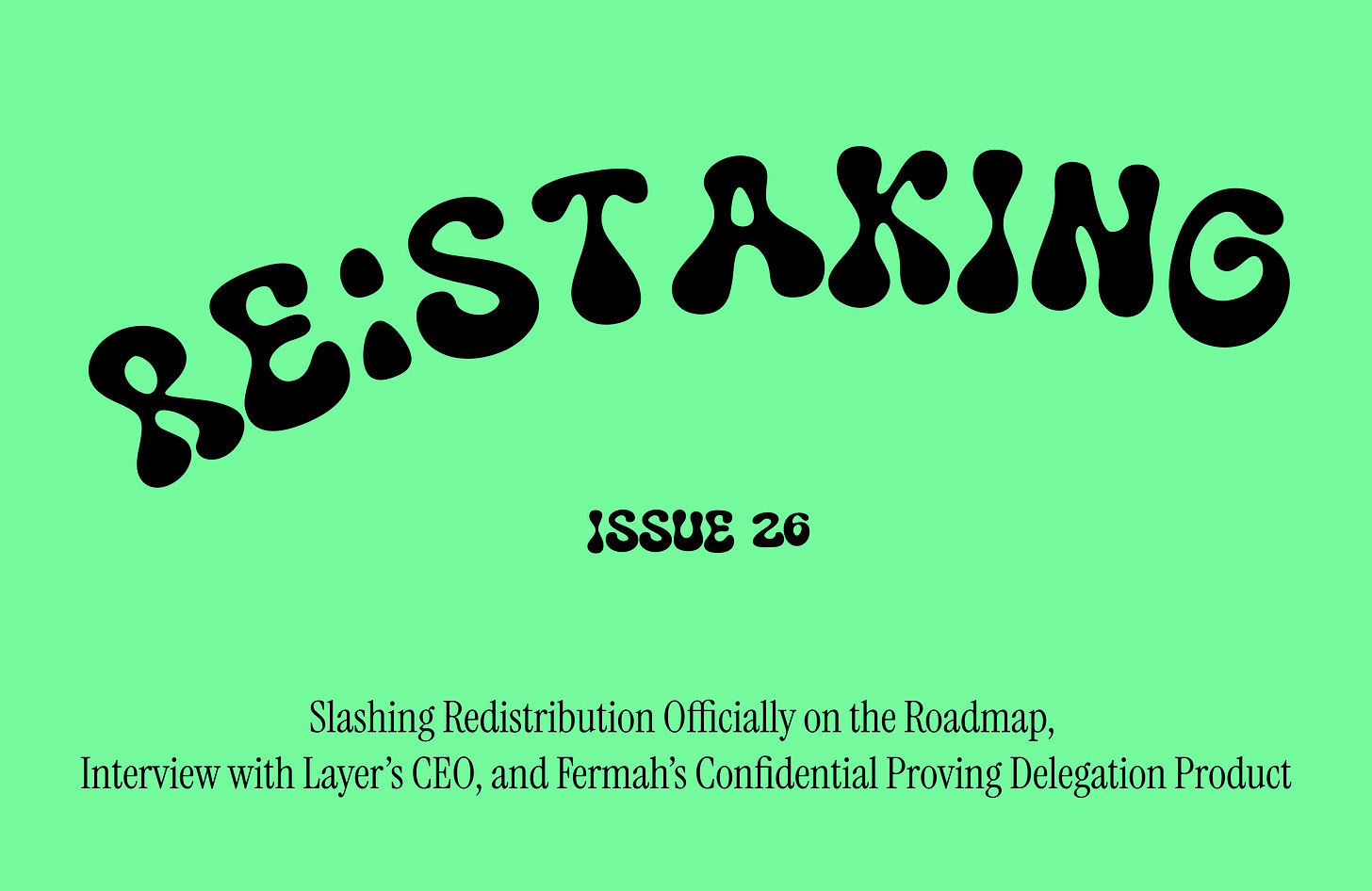Re:Staking Weekly #26
Slashing Redistribution Officially on the Roadmap, Interview with Layer’s CEO, Fermah’s Confidential Proving Delegation Product, and EigenLayer’s Berlin Hacker Village
Welcome to Issue #26 of Re:Staking Weekly! 👋
This week, EigenLayer officially adds slashed asset redistribution to its roadmap as the next major feature following the main slashing release. We break down the implications of this feature and share our updated understanding of why it might be a significant positive for the EigenLayer ecosystem, unlocking a range of new design spaces for AVS.
Also in this issue:
Interview with Layer’s CEO, Jake Hartnell
Fermah’s Confidential Proving Delegation product
EigenLayer’s Berlin Hacker Village
… and more
Let’s go! 🚀
EigenLayer Announces Slashing Redistribution Feature to Its Roadmap
EigenLayer has announced slashing redistribution as part of its roadmap this week, a feature that has been a topic of active discussion in the EigenLayer forum over the past few months. We’ve previously covered the pros and cons of this design, which aims to reduce systemic risk while enhancing restaker incentives.
Slashing redistribution allows assets lost to slashing events to be redistributed according to a predetermined strategy, such as sending funds to a custodian address or directly back to honest operators or restakers. Unlike conventional burn mechanisms, this approach avoids permanent capital loss, reducing the systemic risks to Ethereum and other blue chip assets/ecosystems while potentially boosting restaker participation.
However, slashing redistribution introduces a significant trade-off: operators, who are the only party directly exposed to slashing, may face new forms of downside risk.
A Step Forward or a Step Back?
Initially, I was skeptical about the value of this feature.
While slashing redistribution can reduce systemic risk, it also reintroduces some of the complexities and incentive distortions that the community has sought to avoid:
Incentive Skew – Rewarding honest operators with redistributed assets can create predatory dynamics. Larger operators might attempt to game the system, targeting smaller competitors to capture their staked assets, undermining network fairness.
Economic Security Complexity – Redistribution adds layers of complexity to economic security pricing, potentially leading to less efficient markets where risks are harder to quantify and price correctly.
Lower Returns – Widespread adoption of redistribution could reduce overall returns. As stakes become commoditized and risk profiles blur, yields may shrink, reducing the appeal for restakers.
Opportunity for New Use Cases
However, my perspective has evolved as I’ve come to appreciate the design space that redistribution opens up.
Cap Protocol provides a compelling example. In Cap’s model, protocol users deposit assets to operators, who execute custom strategies to generate yield. Restakers, in turn, provide insurance for these operators, covering potential losses through redistributed stakes if an operator fails. This setup turns the redistribution mechanism into a critical piece of economic security, redefining the role of operators within the EigenLayer ecosystem.
This kind of composability aligns well with EigenLayer’s philosophy of empowering AVSs to define their own risk and reward dynamics. By leaving the asset redistribution strategy to individual AVSs, EigenLayer takes a more flexible, bottom-up approach, potentially unlocking a wide range of novel use cases.
Final Thoughts
While the redistribution model introduces risks around complexity and collusion, it certainly unlocks a broader design space that extends well beyond traditional staking.
Optionality has value. This seems to be a core principle for EigenLayer as it continues to push the boundaries of what restaking can achieve. While adoption may be gradual, the protocol shows no hesitation in rolling out avant-garde features that empower developers to redefine the roles and responsibilities of operators. It’s wild to think operators can move beyond pure infrastructure management and into asset management, fundamentally reshaping the economic dynamics of the ecosystem, and I’m excited to see what’s next.
Breaking the Boundaries of Decentralized Apps with Jake Hartnell, Layer
In this episode, Jake Hartnell, CEO and co-founder of Layer (WAVS), dives deep into the challenges of building full-stack decentralized applications, the role of verifiable off-chain services (AVSs), and why slashing might be the most underappreciated DeFi primitive. Here are the key takeaways:
Full-Stack Decentralization: Layer aims to bridge the gap between smart contracts and full-stack decentralized, verifiable applications, using WebAssembly (WASM) to enable complex off-chain logic.
Slashing as a DeFi Primitive: Slashing is the foundation for decentralized SLAs, insurance pools, and new forms of performance-based tokenomics.
Oracles Beyond Price Feeds: Layer is betting on the long tail of oracles, including niche data sources like satellite feeds and real-world asset verification.
Developer-Centric Platform: Layer drastically reduces the overhead for building AVSs, offering out-of-the-box support for multi-chain event ingestion, cryptographic signing, and cross-chain messaging.
The Potential of WASM: Jake sees WASM as the future of decentralized infrastructure, offering unmatched performance and flexibility that could reshape the entire Web3 stack.
Read More
News Bites
While the concept is similar to its EigenLayer counterpart, Symbiotic features a more expressive and DeFi-friendly vault architecture, enabling parties to design more sophisticated restaking strategies. Learn more about Symbiotic's vault architecture here.
Fermah is introducing the Confidential Proving Delegation product, allowing users to offload ZKP generation to external machines while ensuring the underlying data remains private.
EigenLayer has emerged as the leader in the verifiable service space, with its scope expanding and its potential becoming increasingly tangible.
EigenLayer is hosting its Berlin Hacker Village this June, offering mentorship, grants, and direct support from the EigenLayer team.
That's it for this week's newsletter! As always, feel free to send us a DM or comment directly below with your thoughts or questions.
If you want to catch up with the latest news in the restaking world, give our curated X list a follow!
See you next week and thanks for reading,







